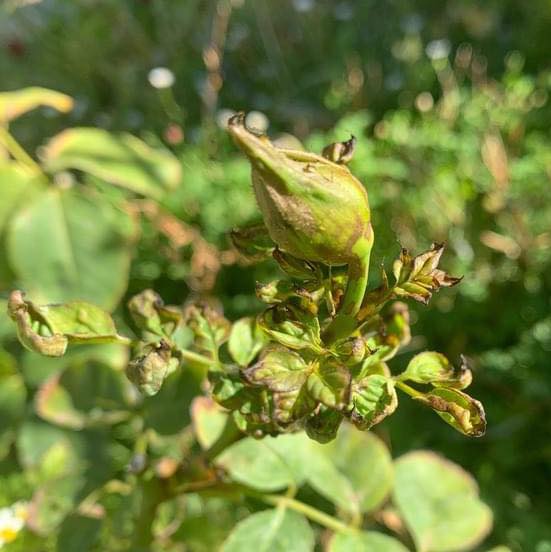No products in the cart.
The Department of Primary Industries and Regional Development, nurseries and rose growers have been inundated with photos and specimens of roses that are suffering from all sorts of symptoms which include:
- Silvering of the leaf surface.
- Curled and distorted leaves with bronzing on leaves, stems and new shoots.
- Grey to black markings on flowers often showing a ring of scarred tissue around the apex.
- Flower buds reduced in size, have a brown colouring and fall off before development.
- Flowers are paler in colour with a brown tips.
The culprit causing the damage are Chilli Thrips known as Scirtothrips dorsalis, a tiny insect less than 2mm in length. These thrips have a punch and suck action, they puncture a hole in plant cells and suck up the sap, this is what causes the mottled effect on the leaves and brown scarring on the rose buds.
Chilli thrips are most active in spring, summer and early autumn if it’s warm and dry. This is their preferred weather and ideal for breeding. Thrips are hard to see with the naked eye but if you get a plain sheet of paper and tap the leaves or flower you may see them moving on the paper. The life cycle of Chilli thrips is complete within 15 days and includes egg, 2 instar larval stages, prepupa, pupa and adult. Eggs will hatch between 2-7 days.
These pesky little insects are polyphagous; meaning they will feed on many different plants. They are now a widespread pest found in Pakistan, Japan, the Solomon Islands, Australia, South Africa, Israel, the Caribbean and America.
Before you reach for the systemic insecticide its worth knowing that they have many predators like lacewings, ladybirds, predatory thrips and predatory mites.
In preparation for Chilli Thrips
As the weather warms up it is inevitable that chilli thrips (Scirtothrips dorsalis) will return to our gardens attacking roses, strawberries, chillies, citrus and many other veggies. The best tactic is to take preventative action early rather than waiting for numbers to build up to plague proportions.
Chilli thrips are hard to see without a magnifying glass, but their tell-tale symptoms are easily noticeable. You will see brown scarring along the leaf veins, flower buds drying turning brown and not forming, light brown spots on stems, curled and dried leaves, and deformed new shoots or flower buds.
Thrips start as an egg, then a larva, pre-pupae and finally a winged adult. After feeding on new shoots the larvae fall to the ground until they reach adult stage and develop wings. They can have many generations and numbers build up quickly particularly in warm weather.
If you have thrips, always collect fallen leaves as this helps prevent the larvae from developing into winged adults and laying eggs.
Spray plants thoroughly with insecticides (listed below) when symptoms first appear, particularly spring flower buds. If you had a really bad infestation last year you may need multiple fortnightly sprays of different products.
If preventative spraying has been left too late, hard pruning of badly affected stems is recommended, bag all pruning’s, and pick up fallen leaves so the life cycle doesn’t continue. So many rose growers resorted to removing their roses last year, but if preventative action is taken when they emerge in spring hopefully the problem won’t be as bad. Management will take commitment and perseverance with severe infestations needing treatment every 7-10 days. All infested growth should be pruned off and pruning tools cleaned between roses. Do not put cuttings in compost or leave it on the ground, bag them before binning them. There are several organic and chemical options for gardeners but will require repeated applications.
Always check for beneficial insects and pollinators before spraying anything on your plants, organic, botanical, or systemic. Be aware that some systemic insecticides containing imidacloprid is harmful to bees and other insects that feed on the sap of plants or collecting pollen. Botanical Insecticides registered for Thrips control that contain pyrethrums, Potassium soaps, Fatty Acids and ethanol, Spinetorum, Botanical Oils.
Organic gardeners can spray with OCP Eco-Oil, Natrasoap Insecticidal Soap, Beat-a-Bug Natural pyrethrum, Yates Natures Way Vegie and Herb spray, Searles Ecofend Natural Solutions mite and insect spray, Hortico Insect Killer Tomatoes and Vegetables, Sharp Shooter Natural Pyrethrum.
If gardeners need to go for stronger more systemic sprays remember some may have a detrimental effect on bees and other beneficial insects. Products that contain active ingredients such as imidacloprid, acetamiprid, spinetoram, or pyrethroids are effective against thrips, and may be available to home gardeners.
Conguard, Success, Mavrick and Richgro Bug Killa have been used by rose growers with some successes are all systemic insecticides that are registered for the control of chilli thrips.
Top Tip: Place blue coloured sticky strips in rose bushes to discover what sap sucking insects are in your garden – use a magnifying glass to get a better view.
Thrips & sucking insects – botanical based registered products
Top Tip
Don’t use any oil-based sprays when temperatures are above 32 degrees as the leaf tissue on plants may burn.

